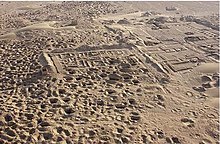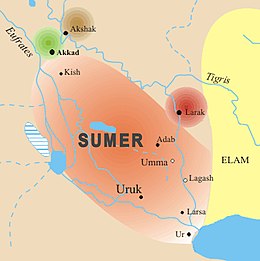ウンマ (シュメールの都市国家)
 ウンマの航空写真 | |
| 所在地 | |
|---|---|
| 地域 | メソポタミア |
| 座標 |
北緯31度40分02秒 東経45度53分15秒 / 北緯31.66722度 東経45.88750度座標: 北緯31度40分02秒 東経45度53分15秒 / 北緯31.66722度 東経45.88750度 |
| 種類 | Settlement |

ウンマ(シュメール語:𒄑𒆵𒆠 ummaKI[1]、現:イラク、ジーカール県、ウンム・アル=アカリブ〈Umm al-Aqarib〉、公式にはジシバン〈Gishban〉とも呼ばれる)はシュメールの古代都市。この遺跡のシュメール語とアッカド語の名称については学術的な議論がある[2]。伝統的にウンマはテル・ジョハ(Tell Jokha)であるとされていた。最近では南東方向に7キロメートル弱の位置にあるウンム・アル=アカリブがウンマであった、あるいはこの両方の名前がウンマであったという説が出されている[3][4]。
歴史[編集]
初期のシュメールのテキスト、『イナンナの冥界下り』において、イナンナ女神は貧困の中で暮らしていたウンマの都市神シャラを冥界に連れ去ろうとする悪魔を思いとどまらせる。悪魔たちは最終的に、豪華絢爛な生活をしていたウルクの王ドゥムジをシャラの代わりに連れ去った[5]。
前2400年頃、エンメテナ王によって記録されたラガシュとの長期にわたる国境紛争が最も良く知られている[6]。この都市は前2275年頃、ルガルザゲシ王の統治の下で最盛期を迎えた。彼はウルとウルクをも支配していた。ウル第3王朝の下で、ウンマは重要な地方的中心となった。ウンマの遺跡で発見された30,000枚を超える粘土板の大半は当時の行政的・政治的文書である。これらによってウンマの出来事について非常に良く見通すことが可能になっている[7]。シュルギ王(在位:前21世紀頃)のウンマ暦は後のバビロニア暦の先駆を成すものであり、パレスチナからの追放後のユダヤ人たちの暦(ユダヤ暦)にも間接的には関わりがある。ウンマは青銅器時代中盤に放棄されたと考えられる[4]。
考古学[編集]
1854年、ウィリアム・ロフタスがテル・ジョハの遺跡を訪れ、1885年にはペンシルベニア大学のジョン・パネット・ピーターズがここを訪れた。1900年代初頭、ウンマから違法に発掘されたウル第3王朝時代の粘土板が数多く骨董市場に出回り始めた[8]。テル・ジョハはウンマの属領であったギシャ(Gisha、Kissa)であると特定されており、ウンマそれ自体の遺跡は約6.5キロメートル南東にあるウンム・アル=アカリブ〈Umm al-Aqarib〉にある。ウンム・アル=アカリブにおいて、考古学者たちは初期王朝時代(前2900年頃-前2300年頃)まで遡る層を発見した。この層には神殿や宮殿であるとされている大規模建造物が含まれている[4][9]。
2017年にスロヴァキア考古・歴史学研究所(the Slovak Archaeological and Historical Institute)がテル・ジョハの発掘を始めた[10]。
略奪[編集]


2003年のイラク侵攻の間、連合軍が爆撃を開始した後、略奪者たちがウンマの遺跡にやってきた。現在、この場所には数百もの溝、盗掘孔があばたのようにあけられている。この過程で、将来の公的な発掘と調査の見通しは非常に暗いものとなった[13] 。
2011年、発展途上国の文化遺産への脅威を監視するアメリカのNGO団体のプロジェクト、グローバル・ヘリテージ・ネットワーク(GHN)が2003年と2010年の航空写真の比較画像を公開し、全体でおおよそ1.12平方キロメートルの範囲における、この期間の略奪者の盗掘孔による破壊の状況を示した[14]。ウンム・アル=アカリブの状況に関連するさらなる画像は、イラクの考古学遺産の破壊についてのタッカー(Tucker)の記事に掲載されている[15]。
ウンマの君主[編集]
キシュの王アッガ(前26世紀頃)は恐らくウンマを占領し、その結果初期王朝時代の間、ザバラは彼に従属していた[16]。
ウンマ第1王朝[編集]
| 君主 | 推定在位年代 | 備考 | |
|---|---|---|---|
| パビルガガルトゥク | 前26世紀 | ウンマのエンシ。彼はラガシュのウル・ナンシェによって捕らわれた[17]。 | |
| ウシュ (ニンタ(Ninta)) |
 |
前2500年頃 | ラガシュを攻撃し、メシリムが設置した境界石を除去した。その後、エアンナトゥムによって破られた.[17]。 |
| エンアカルレ | 前2500年頃-前2400年頃 | エアンナトゥムと国境画定の条約を結んだ[18]。 | |
| ウルルンマ | 前2500年頃-前2400年頃 | エンアカルレの息子。エンアンナトゥム1世に挑んだが、彼の後継者エンメテナに敗れた[18][17]。 | |
| イル | 前2500年頃-前2400年頃 | ウルルンマの後継者。彼はエンアンナトゥム2世に対して反乱を起こし、ウルナンシェの王朝を滅ぼした。[18] | |
| ギシャキドゥ | 2500–2400 BCE | イルの息子[17]。 | |
| エディン | 前2500年頃-前2400年頃 | ウンマの君主[17]。 | |
| メアンネドゥ(Meanedu) | 前2500年頃-前2400年頃 | ウンマの君主[17]。 | |
| ウシュルドゥ(Ushurdu) | 前2500年頃-前2400年頃 | ウンマの君主[17]。 | |
| ウクシュ | 2400–2300 BCE | ルガルザゲシの父.[17]。 | |
| ルガルザゲシ |  |
2400–2300 BCE | 全シュメールを征服し、ウルク第3王朝を築いた。その後アッカドの王サルゴンによって打ち破られた[17]。 |
ウンマ第2王朝[編集]
| 君主 | 推定在位年代 | 備考 | |
|---|---|---|---|
| ルガルアンナトゥム | 前2113年頃 | グティ人の王朝の臣下[17]。 |
脚注[編集]
- ^ “ORACC – Umma”. 2020年10月13日閲覧。
- ^ W. G. Lambert, "The Names of Umma", Journal of Near Eastern Studies, 49 (1990), pp. 75–80.
- ^ [1] Vitali Bartash, "On the Sumerian City UB-meki, the Alleged “Umma”, Cuneiform Digital Library Bulletin 2015:2, Cuneiform Digital Library Initiative, November 2015, ISSN 1540-8760
- ^ a b c Trevor Bryce, The Routledge Handbook of The Peoples and Places of Ancient Western Asia: The Near East from the Early Bronze Age to the fall of the Persian Empire, Routledge, 2009, pp. 738–739.
- ^ Inanna's descent to the netherworld - ETCSL
- ^ Jerrold S. Cooper, History from Ancient Inscriptions: The Lagash-Umma Border Conflict, Undena, 1983, ISBN 0-89003-059-6
- ^ P. A. Parr, "A Letter of Ur-Lisi: Governor of Umma", Journal of Cuneiform Studies, 24 (1972), pp. 135–136
- ^ Georges Contenau, Contribution a l'Histoire Economique d'Umma, Librairie Champion, 1915
- ^ Haider Oraibi Almamori, "The Early Dynastic Monumental Buildings At Umm Al-Aqarib", Iraq, 76 (December 2014), pp. 149-187
- ^ Drahoslav Hulínek and Tibor Lieskovský, Report Archaeological project SAHI - Tell Jokha, 2016, Slovak Archaeological and Historical Institute, 2016
- ^ “Stele of Ushumgal”. www.metmuseum.org. 2020年10月13日閲覧。
- ^ “Site officiel du musée du Louvre”. cartelfr.louvre.fr. 2020年10月13日閲覧。
- ^ [2] Guardian article on Umma looting
- ^ [3] Satellite Imagery Briefing: Monitoring Endangered Cultural Heritage
- ^ Diane Tucker (2009年9月21日). “Brutal Destruction of Iraq's Archaeological Sites Continues”. uruknet.info
- ^ Frayne, Douglas (2009) (英語). The Struggle for Hegemony in "Early Dynastic II" Sumer. The Canadian Society for Mesopotamian Studies 2010. p. 65-66
- ^ a b c d e f g h i j Sallaberger, Walther; Schrakamp, Ingo (2015). History & Philology. Walther Sallaberger & Ingo Schrakamp (eds), Brepols. pp. 74–80. ISBN 978-2-503-53494-7
- ^ a b c Van De Mieroop, Marc (2004). A History of the Ancient Near East: Ca. 3000-323 BC. Wiley. pp. 50–51. ISBN 9780631225522
- ^ King, L. W. (Leonard William) (1910). A history of Sumer and Akkad : an account of the early races of Babylonia from prehistoric times to the foundation of the Babylonian monarchy. London : Chatto & Windus. p. 96
関連項目[編集]
参考文献[編集]
- B. Alster, Geštinanna as Singer and the Chorus of Uruk and Zabalam: UET 6/1 22, JCS, vol. 37, pp. 219–28, 1985
- Tonia M. Sharlach, Provincial taxation and the Ur III State, Brill, 2003, ISBN 90-04-13581-2
- Trevor Bryce, The Routledge Handbook of The Peoples and Places of Ancient Western Asia: The Near East from the Early Bronze Age to the fall of the Persian Empire, Routledge, 2009
- B. R. Foster, Umma in the Sargonic Period, Memoirs of the Connecticut Academy of Arts and Sciences, vol. 20, Hamden, 1982
- Georges Contenau, Umma sous la Dynastie d'Ur, Librarie Paul Geuthner, 1916
- Jacob L. Dahl, The Ruling Family of Ur III Umma: A Prosopographical Analysis of an Elite Family in Southern Iraq 4000 Years ago, Nederlands Instituut voor het Nabije Oosten/Netherlands Institute for the Near East (NINO), 2007, ISBN 90-6258-319-9
- Shin T. Kang, Sumerian economic texts from the Umma archive, University of Illinois Press, 1973, ISBN 0-252-00425-6
- Diana Tucker, "Brutal Destruction of Iraq's Archaeological Sites Continues", online article from September 21, 2009 posted on www.uruknet.info, http://www.uruknet.info/?p=58169



![ウシュムガルの碑(英語版)。前2900年-前2700年頃。恐らくウンマから発見[11]。](http://upload.wikimedia.org/wikipedia/commons/thumb/6/65/Stele_of_Ushumgal_MET_DT849.jpg/157px-Stele_of_Ushumgal_MET_DT849.jpg)

![ウンマの王妃Bara-irnunが、助命されたことを感謝してシャラ神に奉納した飾り板。前2370年頃[12]。](http://upload.wikimedia.org/wikipedia/commons/thumb/0/05/Votive_plaque_of_a_beard-IMG_6857.JPG/133px-Votive_plaque_of_a_beard-IMG_6857.JPG)

